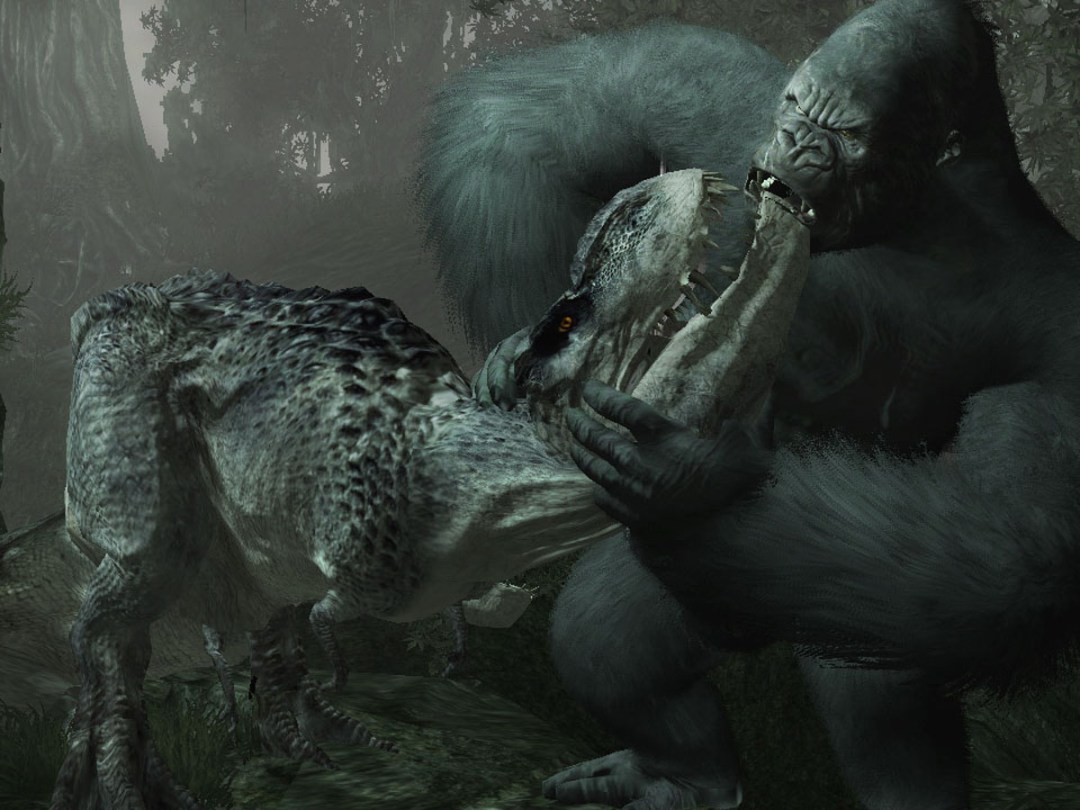20 of the top film tie-in games
Not all movie tie-in videogames suck. No, really – check out our round up of the best examples

Movie tie-in games get a bit of a bad rap – they tend to be dismissed as quick cash-ins, rushed onto store shelves to tie in with a film’s release date.
But among the uninspired platformers and rush-released shooters, there are some gems to be found. We’ve rounded up some of the best games inspired by the silver screen.
Robocop 3 (1993, Amiga)
Robocop 3 was a terrible, terrible film – and the cyborg cop’s previous outings in videogames were clunky, generic platform games. So when Digital Image Design dropped this 3D actioner on Amiga, Atari ST and PC, it was a revelation.
Four different sections were loosely strung together to follow the film’s plot: driving, beat ’em up, flying shoot ’em up and first-person shooter – though you could pick and choose from among them at will. Those blocky 3D graphics might not look like much now, but this was proper 3D driving and gaming years before Quake arrived on the scene.
The Terminator (1990, PC)
A 3D sandbox game, set in an accurately-mapped virtual Los Angeles, in which you boost cars, rob shops and engage in gun battles with cops? No, it isn’t Grand Theft Auto 5 – years before GTA was a twinkle in DMA Design’s eye, Bethesda Softworks’ The Terminator had you causing vehicular mayhem on the streets of LA. It even stirred up controversy in the press with its “death animations,” which depicted the gory demise of its blocky characters in close-up.
Although you had the choice of playing as the Terminator or Sarah Connor’s protector Kyle Reese, let’s be honest – everyone wanted to be Arnie.
Batman: The Movie (1989, Amiga/Atari ST)
Until 1989, Batman’s most striking movie presence consisted of a man in grey tights and a black mask with chalked-on eyebrows. Then Tim Burton changed all that with his reboot of the franchise, finally giving developer Ocean something to work with.
Batman: The Movie: The Game consists of a series of sub-games, ranging from platforming action in the Axis chemical plant to cruising through Gotham in the Batmobile, hooking onto lamp posts with your trusty Batarang. Have you ever danced with the devil by the pale moonlight? No, neither have we. But we have hopped through a cathedral very, very slowly.
The Warriors (2005, PS2)
Taking a break from the mighty Grand Theft Auto series, Rockstar Games put its creative talents to work on The Warriors – based on the 1979 cult action thriller. Taking place in 1970s New York, it was up to you to punch, kick and generally use violent methods to progress. Bit like GTA, then. Many of the actors from the film helped with the voiceover, making this a more authentic game movie tie-in than most.
The Chronicles of Riddick: Escape from Butcher Bay (2004, Xbox)
In 2004, you could watch Vin Diesel’s pulp anti-hero Riddick on the big screen in the bloated epic The Chronicles of Riddick – or you could fire up your Xbox and play Starbreeze’s taut prison-break prequel. Mixing stealth and FPS action with a richly-detailed world populated by fellow prisoners (all of whom have their own personality and routine), it shames those movie tie-in games that sling together some action sequences and a couple of cutscenes and call it a day.
GoldenEye 007 (1997, N64)
Not many games start a level by dropping you through an air vent into the gents’ loos in a Soviet military base, but that’s one of many reasons why this game was so very good. Its single-player campaign mixed stealth and explosions with great success, but where this game really came into its own was in the multiplayer mode. Basic by today’s standards, yes, but having four players trying to kill off each other from their quarter-screen view was incredibly exciting. Licence to Kill. Pistols. No, you can’t be Oddjob…
Spider-Man 2: The Game (2004, PS2)
Spider-Man 2 combined GTA‘s open-world sandbox magic with Spider-Man’s arachnid superpowers, and the end result was every aspiring superhero’s dream. Unlike its predecessor, which saw you disappointingly shooting web randomly into mist, Spider-Man 2 let you hit buildings and lampposts, giving you full freedom to web swing around an open city in three dimensions. It took days for us to even start the main mission, such was our addiction to the freedom of web swinging. Never had the guts to try it out in real life, mind.
Peter Jackson’s King Kong: The Official Game of the Movie (2005, PS2/Xbox 360/PC)
Clearly aiming to retrieve the longest game title accolade from Riddick, Peter’s Jackson’s King Kong: The Official Game of the Movie was one of the launch titles for the Xbox 360. Mixing first-person shooter action with third-person sequences in which you actually got to play as Kong, it featured fantastic graphics and an entertaining combo of ammo conservation and puzzle-solving.
Finish the game a second time and rack up 250,000 points and you’re treated to a happier ending, in which Kong climbs down from the Empire State Building and returns to Skull Island to live out his days in peace.
Dune II (1992, PC/Amiga)
Based on David Lynch’s 1984 movie adaptation of Frank Herbert’s 1965 sci-fi novel, this one was a long time coming. But it was worth the wait and can claim the honour of being the game that really kicked off the real-time strategy genre, spawning the likes of Command and Conquer and Starcraft. A simple premise – mine valuable Spice from the planet Arrakis and defend territory from rivals. It was so insanely addictive that we’ve kept our coriander under close guard ever since. If you want a quick reminisence, head over to play-dune.com where you can play Dune II in your browser.
Lego Star Wars: The Video Game (2005, PS2/Xbox)
Combining Lego, the Star Wars prequels and a videogame sounds like a recipe for disaster – but like a beautiful construction made out of mismatched Lego bricks, it all fits together perfectly. An addictive mix of puzzle solving, action and memorable set-pieces inspired by the films – with a dash of wit – made for a masterpiece that was, frankly, vastly better than watching Jar-Jar Binks capering about on the big screen.
The Lion King (1994, Super NES/Sega Mega Drive)
Forget the child-friendly Disney association, The Lion King harkened back to a time when video games were harder to finish than a Rubik’s Cube – even on easy. In fact, only the most gifted children and adults ever made it past the first few levels, let alone make it to fighting the evil uncle, Scar. Besides a great soundtrack that was true to the film and equally impressive 2D visuals drawn by actual Disney animators, it was one of the few games published by old Richard Branson. Well, not him personally.
X-Men Origins: Wolverine (2009, PS3/Xbox 360)
On the big screen, X-Men Origins: Wolverine was a benighted mish-mash of mutants and TV movie-quality direction. As a video game, though, it delivered brutal God of War-style action courtesy of the ol’ Canucklehead’s adimantium claws. And those claws unleash rivers of gore that you’d never get to see in the X-Men films – the game really does show you a feral side of Wolverine that Hugh Jackman’s portrayal has never quite managed. BioShock-style mutagen upgrades and unlockable costumes mean it has plenty of replay value, too – though the game does lose points for featuring the voice talents of Will.i.Am.
Disney’s Aladdin (1993, Sega Mega Drive)
Disney’s Arabian street rat with a genie problem bounced onto the Sega Mega Drive as a 1993 platformer chock full of sword swinging action interspersed with acrobatic parkour-esque gameplay in the back streets of Agrabah. Occasional Genie bonus rounds allow for stocking up on powerups and points on the way to the showdown in Jafar’s palace. Another version was developed separately for the SNES – which was also pretty good, though the Mega Drive version just edges it (you get a sword!). The SNES version didn’t feature the music from the film, but we can’t decide whether that’s a good or a bad thing.
We still shudder at the thought of those dreaded boulder levels like it was yesterday.
Kung Fu Panda (2008, PS3/Xbox 360)
Those who craved the ability to beat up animals while playing as a panda were well catered for, thanks to the video game based very loosely on the Dreamworks Animation film of the same name. It won an award for its slick animation, and while a little on the easy side for those older than its intended audience, there was gameplay goodness to be had as you worked your way up to becoming the revered Dragon Warrior.
Tron (1982, arcade)
Given Tron‘s virtual reality setting, a videogame was almost a no-brainer. And although less well remembered than the film, the Tron arcade game delivered four mini-games based on different parts of the film. Yeah, four mini-games – though the one everybody remembers is the Light Cycle section, which took the classic Snake game (later seen on Nokia phones) and added a competitive element. You had to steer your Light Cycle from a top-down perspective and blow up your opponenet using the light trail behind you, just like in the film.
Star Wars (1983, arcade)
Ignoring all the preamble of Jedi, Tatooine and faffing about on the Death Star, the Star Wars arcade game got straight to the exciting bit of the film – the fighter attack on the Imperial battle station. First, you had to battle through waves of TIE Fighters, lovingly rendered in wireframe vector graphics (and inexplicably firing what appeared to be psychedelic snowflakes at you). Then it was down to the Death Star surface, where you fought your way through gun towers to complete the famous trench run.
If you were really lucky, your local arcade had one of the sit-down versions, so you could pretend you really were Luke Skywalker. Until one of the bigger kids turfed you out, despite the stack of coins which clearly indicated you had reserved your spot.
Indiana Jones and the Last Crusade: The Graphic Adventure (1989, PC/Amiga/Atari ST)
LucasArts released two games to tie in with Indiana Jones’ final on-screen adventure (shut up, Crystal Skull and Dial of Destiny were just a bad dream). Of the two – an action platformer and a point-and-click adventure game – The Graphic Adventure is the more fondly remembered. Making use of the SCUMM engine that underpinned the likes of Maniac Mansion and later The Secret of Monkey Island, the game featured a clever ‘Indy Quotient’ system that racked up points depending on how you approached the puzzles. The only way to achieve the maximum possible score was to play the game multiple times, taking a different route on each occasion.
Angry Birds Star Wars (2012, iOS/Android)
It was hard not to be cynical when we first heard of the irate avians’ tie-in with Star Wars – expecting it to be just another poorly thought-out licensing deal. But we were wrong – as well as including some of the brilliant gravity-defying obstacles from Angry Birds Space, it adds in Star Wars-themed birds with lightsabers, blasters and Force push powers. This adds a grin-inducing theme for Star Wars fans, and brings new depth to gameplay. It’s been so successful that a sequel has just been released. Just beware the pork side…
Ghostbusters (1984, Commodore 64)
Like all the best vintage games, this C64 effort from Activision kept things varied, with driving sections, ghost-trapping combat sections and a race against the clock to pay off your US$10,000 loan before New York City’s PK energy hit 9999 and the demon Zuul puts in an appearance. Because keeping your finances in order is more important than the end of the world. Many a joystick was flung at the screen during the maddening bit where you have to dodge the Marshmallow Man.
Blade Runner (1997, PC)
A bit of a fudge, this one, as it isn’t really an adaptation of the film – rather than playing Harrison Ford’s Rick Deckard, you play similarly attired Blade Runner Ray McCoy in a point-and-click adventure that runs parallel with the events of the movie. Westwood Studios admirably recreates the atmosphere of Ridley Scott’s dystopian future, with McCoy encountering characters and environments from the Blade Runner film.
The game riffs on the film’s themes of identity, too – each time you play, the game randomly determines which characters are humans and which are android replicants, and the ending changes depending on whether you treat the replicants with compassion or hunt them down.



